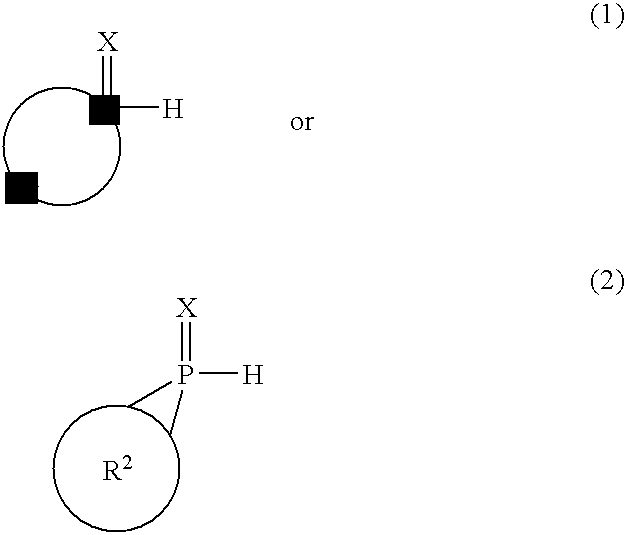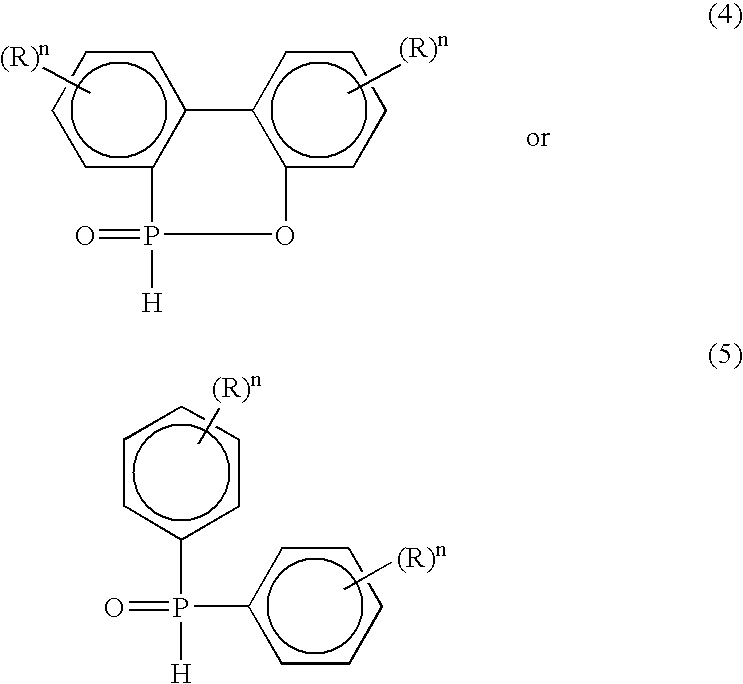Phosphorus- containing epoxy resin, phosphorus- containing epoxy resin composition, process for producing the resin, sealant containing the composition, molding material containing the composition, and laminate containing the composition
- Summary
- Abstract
- Description
- Claims
- Application Information
AI Technical Summary
Benefits of technology
Problems solved by technology
Method used
Image
Examples
example 1
[0088] Into a reactor, 1,843 g (16.69 mol) of 1,5-cyclooctadiene manufactured by Tokyo Kasei Kogyo Co., Ltd. and 3,750 ml of toluene were fed, and an atmosphere in the resulting reactor was fully replaced with nitrogen. Into the resulting reactor, 731 g (21.50 mol) of phosphine manufactured by Nippon Chemical Industrial Co., Ltd. was fed, and the resulting reactor was heated to 60° C. Into the resulting reactor, 58.8 g (0.237 mol) of 2,2-azobis-(2,4-dimethylvaleronitrile), manufactured by Japan Hydrazine Company Inc., functioning as a radical initiator was injected with a pressure while three hours were spent. The mixture was maintained at 60° C. and left overnight, thereby obtaining a toluene solution containing a mixture of 1,4-cyclooctylenephosphine and 1,5-cyclooctylenephosphine. The solution was analyzed by gas chromatography. The analysis showed that the content of the mixture in the solution was 31.9 percent by weight and the ratio of 1,4-cyclooctylenephosphine to 1,5-cyclooc...
example 2
[0090] Into a reactor, 120.0 g of an o-cresol novolac epoxy resin (Epototo YDCN-701, manufactured by Tohto Kasei Co., Ltd., having an epoxy equivalent of 200.2 g / eq) was fed, and the reactor was then heated to 120° C. Into the resulting reactor, 22.72 g of the mixture, prepared in Example 1, containing 1,4-cyclooctylenephosphine oxide and 1,5-cyclooctylenephosphine oxide was fed. Subsequently, 0.047 g of triphenylphosphine functioning as a catalyst was fed into the reactor while the mixture in the reactor was agitated, and the reactor was then heated to 150° C. After 30 minutes, a transparent melt was produced in the reactor. Agitation was further continued for eight hours and the reactor was then cooled, whereby a white solid was obtained. The solid was mashed in a mortar, whereby 141.8 g of white powder was obtained. The white powder was a phosphorus-containing epoxy resin (hereinafter referred to as resin A) having an epoxy equivalent of 311.2 g / eq and a phosphorus content of 3.1...
example 3
[0094] Into a reactor, 30.45 g of a phenol novolac epoxy resin (Epototo YDPN-638, manufactured by Tohto Kasei Co., Ltd., having an epoxy equivalent of 178.2 g / eq) was fed, and the reactor was then heated to 80° C. Into the resulting reactor, 6.08 g of the mixture, prepared in Example 1, containing 1,4-cyclooctylenephosphine oxide and 1,5-cyclooctylenephosphine oxide was fed. Subsequently, 0.024 g of triphenylphosphine functioning as a catalyst was fed into the reactor while the mixture in the reactor was agitated, and the reactor was then heated to 150° C. After 30 minutes, a transparent melt was produced in the reactor. Agitation was further continued for eight hours and the reactor was then cooled, whereby a white solid was obtained. The solid was mashed in a mortar, whereby 35.7 g of white powder was obtained. The white powder was a phosphorus-containing epoxy resin (hereinafter referred to as resin B) having an epoxy equivalent of 281.6 g / eq and a phosphorus content of 3.2 perce...
PUM
| Property | Measurement | Unit |
|---|---|---|
| Fraction | aaaaa | aaaaa |
| Percent by mass | aaaaa | aaaaa |
Abstract
Description
Claims
Application Information
 Login to View More
Login to View More - R&D
- Intellectual Property
- Life Sciences
- Materials
- Tech Scout
- Unparalleled Data Quality
- Higher Quality Content
- 60% Fewer Hallucinations
Browse by: Latest US Patents, China's latest patents, Technical Efficacy Thesaurus, Application Domain, Technology Topic, Popular Technical Reports.
© 2025 PatSnap. All rights reserved.Legal|Privacy policy|Modern Slavery Act Transparency Statement|Sitemap|About US| Contact US: help@patsnap.com



